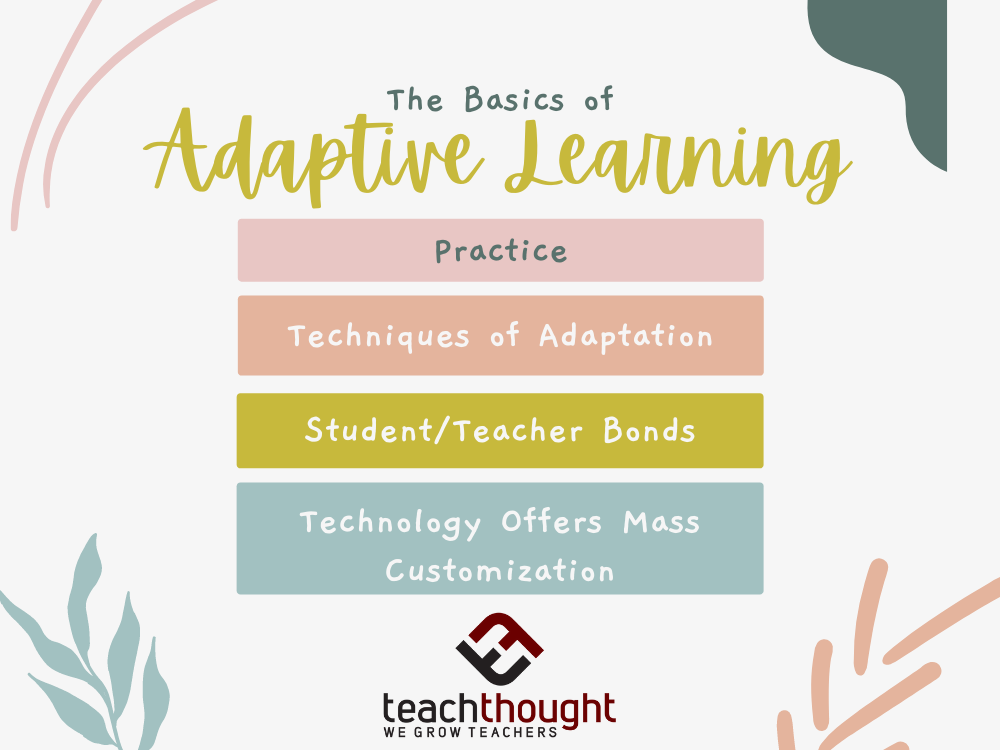
What Are The Basics Of Adaptive Learning?
by TeachThought Staff
Traditional education assumes that students by and large all learn in the same way: Start from Problem A and work on through to Problem Z. Bogged down on Problem D, a student will likely fail a quiz and scramble to catch up.
Adaptive learning technologies work from the premise that there are other, more personalized ways of acquiring knowledge. Essentially, adaptive learning proposes that technology can be leveraged to mold the learning experience to individual students’ needs and learning styles. This style of teaching “tailors the educational process to the strengths and weaknesses of individual students,” according to education trends sites.
How does it work? Vendor PrepMyFuture offers this analogy.
Suppose a technology system could track and remember all the music you listen to. After a few days it might generate a playlist based on your tastes. A really good system might even recognize that you like cool jazz after work, and would program itself to suit your need.
Take the same idea and apply it in a learning situation. Suppose a student is prepping for a geography exam. Adaptive learning technology could note which countries are identified correctly or incorrectly. Then instead of quizzing the student at random, the program would begin to offer more practice in those areas that are weak.
1. Practice
In this way, adaptive learning is able to embrace dynamic content and shape it to fit the individual learner. The software could track and respond to a range of online interactions by the student, such as reading a book online or engaging in social media. All data from such interactions could in theory be fit into the system’s overall profile of what the student does or does not know.
By following a student’s education over time, the system also could build up a picture of that individual’s learning style, information that could help determine for example the speed and sequence with which new information ought to be delivered. “Continuous adaptive learning can provide this by determining a student’s ability and ‘serving up’ questions at just the right level,” according to Pearson Learning Solutions, a provider of educational materials and technologies.
Another use would be in practice testing. As students make their mistakes, adaptive learning technologies could chart the weak points and use those as a starting point for further review.
Language education, too, has proven a fruitful arena for adaptive learning. Software vendors such as iKnow have produced packages tailored to specific languages: Typically, they drill vocabulary and spelling and offer extensive quizzing. With each iteration, the software hones in more closely on the particular learner’s strengths and weaknesses.
2. Techniques of Adaptation
Adaptive learning uses a number of strategies to personalize learning. One common method is scaffolding, or cognitive scaffolding. In this scenario the system creates a series of building blocks from simple to complex, escalating the student higher up as each level is completed.
Another strategy focuses on mastery, the idea that any student can reach a certain pinnacle of achievement in the acquisition of knowledge. The adaptive learning system continually reinforces strengths while encouraging practice in weaker areas in order to reach that height.
Some systems will take a “games” approach, motivating participants with points for making their way up the ranks. Students are motivated to reach their “high score” and thus have a reason to strive for achievement.
3. Student/teacher Bonds
As with any technology-based learning system, some have raised concerns about the breakdown in student/teacher interaction. Advocates argue that in fact, adaptive learning can enhance that bond: If students come to class better prepared, that makes room for deeper, more substantive conversations between teacher and student.
Adaptive education technologies often can lead to improved student course mastery while delivering the ability for educators to track proficiency and mastery by each individual student, according to the Sloan Consortium (sloanconsortium.com), an organization dedicated to integrating online education into the mainstream of higher education. Being computer-based, adaptive learning tools can record students’ time and activity within an area of study. Educators could use this data as a way to understand student behaviors and to spot problem situations before they can evolve too far.
In any case, there is nothing to say that adaptive technologies should take the place of a live interface. Rather, proponents see the educational technology largely as a supplement to the ordinary business of face-to-face learning.
Skeptics have asked whether learning can be reduced to software and whether algorithms can successfully intuit the complex process by which the brain acquires knowledge. One company, Grockit, says it can overcome such objections by focusing on a “social” model. Its tools allow students to collaborate through various social media, taking the experience beyond the merely mechanized.
4. Technology Offers Mass Customization
Probably the greatest achievement of adaptive learning is its ability to drive two seemingly conflicting educational ends simultaneously. On the one hand, personalization and customization can be a tremendous boon to the learning process. The more material can be fine-tuned for the needs of a particular learner, the greater the chances of success in that subject area.
At the same time, though, educators strive to reach as broad a group of learners as possible. There would seem to be a conflict: The desire to customize, and the need to cast a broad net. It’s here that adaptive learning succeeds best. Deliverable via the Internet, these education technologies offer a kind of mass customization. As leading technology vendor Knewton describes it, “[t]he aim of adaptive learning is to deliver personalized learning and instruction on a large scale.” Many learners, each given personalized content management: an achievement both pedagogical and technological.
This is a cross-post from onlineschools.com; image attribution flickr user josekevo
